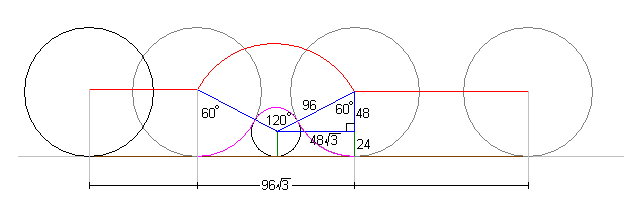2007 AIME II Problems/Problem 11
Problem
Two long cylindrical tubes of the same length but different diameters lie parallel to each other on a flat surface. The larger tube has radius ![]() and rolls along the surface toward the smaller tube, which has radius
and rolls along the surface toward the smaller tube, which has radius ![]() . It rolls over the smaller tube and continues rolling along the flat surface until it comes to rest on the same point of its circumference as it started, having made one complete revolution. If the smaller tube never moves, and the rolling occurs with no slipping, the larger tube ends up a distance
. It rolls over the smaller tube and continues rolling along the flat surface until it comes to rest on the same point of its circumference as it started, having made one complete revolution. If the smaller tube never moves, and the rolling occurs with no slipping, the larger tube ends up a distance ![]() from where it starts. The distance
from where it starts. The distance ![]() can be expressed in the form
can be expressed in the form ![]() where
where ![]()
![]() and
and ![]() are integers and
are integers and ![]() is not divisible by the square of any prime. Find
is not divisible by the square of any prime. Find ![]()
Solution
If it weren’t for the small tube, the larger tube would travel ![]() . Consider the distance from which the larger tube first contacts the smaller tube, until when it completely loses contact with the smaller tube.
. Consider the distance from which the larger tube first contacts the smaller tube, until when it completely loses contact with the smaller tube.
Drawing the radii as shown in the diagram, notice that the hypotenuse of the right triangle in the diagram has a length of ![]() . The horizontal line divides the radius of the larger circle into
. The horizontal line divides the radius of the larger circle into ![]() on the top half, which indicates that the right triangle has leg of 48 and hypotenuse of 96, a
on the top half, which indicates that the right triangle has leg of 48 and hypotenuse of 96, a ![]() .
.
Find the length of the purple arc in the diagram (the distance the tube rolled, but not the horizontal distance). The sixty degree central angle indicates to take ![]() of the circumference of the larger circle (twice), while the
of the circumference of the larger circle (twice), while the ![]() central angle in the smaller circle indicates to take
central angle in the smaller circle indicates to take ![]() of the circumference. This adds up to
of the circumference. This adds up to ![]() .
.
The actual horizontal distance it takes can be found by using the ![]() s. The missing leg is equal in length to
s. The missing leg is equal in length to ![]() . Thus, the total horizontal distance covered is
. Thus, the total horizontal distance covered is ![]() .
.
Thus, we get ![]() , and our answer is
, and our answer is ![]() .
.
See also
| 2007 AIME II (Problems • Answer Key • Resources) | ||
| Preceded by Problem 10 |
Followed by Problem 12 | |
| 1 • 2 • 3 • 4 • 5 • 6 • 7 • 8 • 9 • 10 • 11 • 12 • 13 • 14 • 15 | ||
| All AIME Problems and Solutions | ||
The problems on this page are copyrighted by the Mathematical Association of America's American Mathematics Competitions. ![]()










